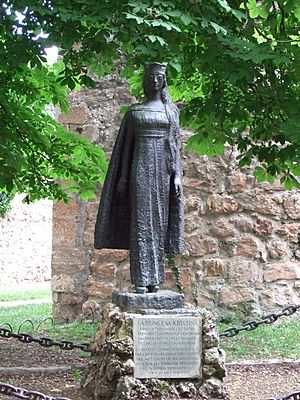Christina of Norway, Infanta of Castile facts for kids
Quick facts for kids Kristina of Norway |
|
|---|---|

Statue of Infanta Christina made by artist Brit Sørensen in Covarrubias, Spain, a copy was later erected in Tønsberg
|
|
| Born | 1234 Bergen, Norway |
| Died | 1262 (aged 27–28) Seville, Castile |
| Burial | Covarrubias, Castile |
| Spouse | Infante Philip of Castile |
| House | Sverre |
| Father | Haakon IV of Norway |
| Mother | Margaret Skulesdatter |
| Religion | Roman Catholicism |
Christina of Norway (Norwegian: Kristina Håkonsdotter) was a princess born in Bergen, Norway, in 1234. Her father was King Håkon IV and her mother was Margaret Skulesdatter. As part of an important agreement between Norway and Spain, she was chosen to marry Prince Philip, who was the brother of King Alfonso X of Castile.
Christina and Philip were married in 1258. She lived in Castile, Spain, for four years until she passed away in 1262. It is said that Christina wished for a church to be built in Spain to honor Saint Olaf, a very important Norwegian saint. Many years later, a modern church was indeed built and dedicated to Saint Olaf in Covarrubias, Spain.
Contents
A Princess's Journey to Spain
In 1255, King Håkon of Norway sent a group of people to Castile in Spain. They brought gifts like falcons, furs, and leather for the Spanish court. The Norwegian visitors were welcomed by King Alfonso X. The next year, when they returned to Norway, Spanish representatives came with them.
One of the Spanish visitors, Sira Ferrant, asked King Håkon if his daughter Christina could marry one of King Alfonso's brothers. King Håkon thought carefully about this request. He talked with his archbishop and other wise people. He agreed, but only if Christina could choose her husband from among the king's brothers herself.
Christina left Tønsberg, Norway, in the summer of 1257. Her group was very large, with more than 100 people. They sailed across the North Sea to England, then crossed the English Channel to France. From there, they rode horses across France to the Spanish border.
In Barcelona, they met King James I of Aragon, who was King Alfonso X's father-in-law. He was very impressed by Christina's beauty. On Christmas Eve in 1257, the group stayed at the Abbey of Santa María la Real de Las Huelgas in Burgos. This abbey is still standing today.
Meeting the Prince
In Palencia, King Alfonso officially met the Norwegians. He went with them to the city of Valladolid on January 3, 1258. Christina was warmly welcomed by everyone in the city. There, she met King Alfonso's brothers for the first time. She chose the youngest brother, Philip. He was three years older than Christina.
Prince Philip had been trained for a life in the church. He was in charge of the church at Covarrubias. However, he really loved hunting boars and bears more than church duties. His father, Ferdinand III of Castile, had wanted him to be a church leader. But after his father died, Philip decided to leave that role.
Marriage and Legacy
Prince Philip and Christina of Norway were married on March 31, 1258. Their wedding took place in the Santa Maria la Mayor church in Valladolid. We do not have many details about what their marriage was like. They did not have any children. Just four years later, Christina died in Seville at the age of 28.
Christina's body was taken to the abbey church in Covarrubias, Spain. This town is about 40 kilometers (25 miles) south of Burgos. Her wooden casket was placed inside a simple stone sarcophagus, which was decorated with carved grape leaves.
Christina's Tomb Discovered
In 1952, Christina's sarcophagus was opened by workers who were doing restoration work. The local priest, Father Rufino Vargas Blanco, was shown a piece of parchment found inside the casket. The lid was put back on. Later, in 1958, the tomb was officially opened again. This was partly because an old church document from 1757 said that this was where Princess Christina was buried. The year 1958 was also 700 years after her marriage.
Experts studied what was found. They confirmed that the stone was from the area and the fabrics inside were from the 13th century. Doctors who examined the remains said:
A partially preserved skeleton with a length of 1.72 m (5 ft 8") – the skull is small and all the teeth are well preserved with no evidence of tooth decay...Everything points to a skeleton of a woman who was tall, young, and strong...
A Lasting Connection
The cities of Tønsberg, Norway, and Covarrubias, Spain, have become "friendship cities" because of Christina's story. In 1978, a statue of Princess Christina, made by artist Brit Sørensen, was put up in Covarrubias. A copy of this statue was later placed in Tønsberg. The Princess Christina Foundation was created to help keep these cultural and historical ties strong.
As tradition says, Christina wanted a church built in Spain for Saint Olaf. A modern church, designed by architect Pablo López Aguado, has been built in Covarrubias, Spain. Countries like Iceland, Liechtenstein, and Norway helped pay for a large part of the church. Spanish and Norwegian companies also contributed.
750 years after Christina's marriage, the church was finished and opened on September 18, 2011. Many people from Spain and Norway, along with over 1300 visitors, were there for the opening. For many years now, Covarrubias has become a special place for Norwegians to visit the final resting place of their princess.
See also
 In Spanish: Cristina de Noruega para niños
In Spanish: Cristina de Noruega para niños



